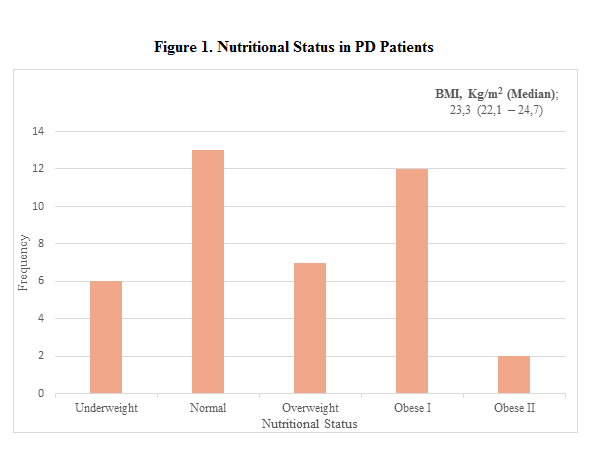Category: Other
Objective: This study aimed to describe and determine the prevalence of nutritional status in outpatient Parkinson’s Disease (PD) patients.
Background: Parkinson’s disease is the most common form of parkinsonism, making up 80% of parkinsonism cases [1]. PD was very well known as a disease that worsens slowly with time. As a consequence of the disease, nutritional status in PD patients could decline as the disease progresses. Some studies also show that the PD population was at risk of malnutrition [2,3].
Method: This research was a cross-sectional descriptive study in PD patients in outpatient clinic settings. The nutritional status was determined using the body mass index (BMI), and WHO-Asian classification of BMI was used. Bivariate analyses were used to find an association between PD patients’ characteristics and nutritional status.
Results: Forty subjects were studied, with a median duration of the disease of 5.03 years. The median age was 66.0 years old, dominated by males (57.5%). Most of the subjects were in stage 2 Hoehn and Yahr Scale (45%) and treated with a combination of levodopa and dopamine agonist (47.5%). The median BMI was 23.3, and most of the subjects’ nutritional status was normal (32,5%), followed by obese I (30%). Subjects with longer duration (more than 5 years) showed a higher percentage of underweight status (15,4%). Subjects with later stages of the disease presented a higher proportion of underweight nutritional status (23,1%). We found no significant association between nutritional status and PD patients’ characteristics such as age, gender, onset and stage of the disease, or the therapy used.
Conclusion: The majority of PD patients in this study have normal nutritional status, followed by obesity. Subjects with the longer onset and later stages of the disease have a higher prevalence of underweight nutritional status. Even though there was no association between PD patients’ characteristics and nutritional status found in this study, it is worth noticing that patients with PD were at risk for malnutrition and underweight nutritional status as the disease progressed.
References: 1.Brust J.M.(Ed.), (2019). CURRENT Diagnosis & Treatment: Neurology, 3e. McGraw Hill.
2.Ghourchian S, Gruber-Baldini AL, Shakya S, Herndon J, Reich SG, von Coelln R, Savitt JM, Shulman LM. Weight loss and weight gain in Parkinson’s disease. Parkinsonism Relat Disord. 2021 Feb;83:31-36. DOI: 10.1016/j.parkreldis.2020.12.018. Epub 2021 Jan 12. PMID: 33465545.
3.Fernandez RD, Campos JSDP, Santos TOCG. Nutritional status and food consumption of patients with Parkinson’s disease. Arq Neuropsiquiatr. 2021 Aug;79(8):676-681. DOI: 10.1590/0004-282X-ANP-2020-0053. PMID: 34550185.
To cite this abstract in AMA style:
SS. Musthafa, D. Tunjungsari, A. Tiksnadi. Nutritional Status of Patients with Parkinson’s Disease: Report from Indonesian Tertiary Referral Hospital [abstract]. Mov Disord. 2022; 37 (suppl 2). https://www.mdsabstracts.org/abstract/nutritional-status-of-patients-with-parkinsons-disease-report-from-indonesian-tertiary-referral-hospital/. Accessed December 16, 2025.« Back to 2022 International Congress
MDS Abstracts - https://www.mdsabstracts.org/abstract/nutritional-status-of-patients-with-parkinsons-disease-report-from-indonesian-tertiary-referral-hospital/

